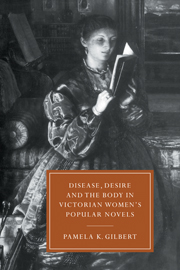Book contents
- Frontmatter
- Contents
- Acknowledgments
- Introduction
- 1 “In the body of the text”: metaphors of reading and the body
- 2 Genre: the social construction of sensation
- 3 M. E. Braddon: sensational realism
- 4 Rhoda Broughton: anything but love
- 5 Ouida: romantic exchange
- Afterword: the other Victorians
- Notes
- Bibliography
- Index
- CAMBRIDGE STUDIES IN NINETEENTH-CENTURY LITERATURE AND CULTURE
3 - M. E. Braddon: sensational realism
Published online by Cambridge University Press: 16 November 2009
- Frontmatter
- Contents
- Acknowledgments
- Introduction
- 1 “In the body of the text”: metaphors of reading and the body
- 2 Genre: the social construction of sensation
- 3 M. E. Braddon: sensational realism
- 4 Rhoda Broughton: anything but love
- 5 Ouida: romantic exchange
- Afterword: the other Victorians
- Notes
- Bibliography
- Index
- CAMBRIDGE STUDIES IN NINETEENTH-CENTURY LITERATURE AND CULTURE
Summary
M. E. Braddon (1835–1915), certainly one of the most prolific authors and editors of the period, is central to any understanding of the Victorian novel. Although she came to the middle-class public's attention with Lady Audley's Secret and Aurora Floyd in 1862, in fact she had been writing for six years. Braddon's production encompasses over seventy novels, many short stories, plays, essays, and the editorship of several journals, most notably Belgravia and The Mistletoe Bough.
Braddon's understanding of the book trade in which and by which she lived is clear-eyed, canny, and comprehensive. Unlike Rhoda Broughton, who had a comfortable social position independent of her literary earnings, Braddon supported herself, her family, and her lover's family by her literary activities. After being “typecast” as The Sensation Novelist after her early two bestsellers – a designation which itself is open to inquiry – Braddon found herself in active competition with the public and critical construction of her and her early work for control of the generic designation and market placement of her many other novels. In the sensation novel, the woman's body is clearly foregrounded. However, in her later novels of any genre, Braddon's constant rewriting of her own position in the marketplace and use of multiple genres to manipulate her placement brings her inevitably back to the woman's body as a site of reading and generic designation. Her reading of the place of the woman's body, as reader, author, and text, forms the substance of her rewriting of Madame Bovary, The Doctor's Wife, in which she comments on the place of literature, literary genres, the market, and reading practices.
- Type
- Chapter
- Information
- Publisher: Cambridge University PressPrint publication year: 1997



